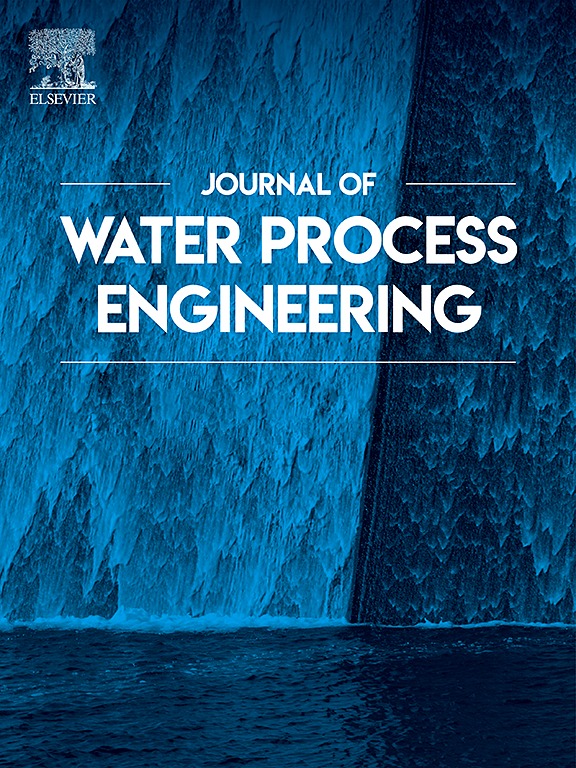A framework for integrating algal-bacterial mechanistic modelling and Life-cycle Assessment in wastewater treatment processes
IF 6.7
2区 工程技术
Q1 ENGINEERING, CHEMICAL
引用次数: 0
Abstract
Algae offer a promising route towards sustainable practices in wastewater treatment applications, but their true environmental performance remains difficult to evaluate using static, empirical data. Here, we introduce a framework that integrates bioprocess modelling with Life-Cycle Assessment (LCA) to improve the robustness of environmental impact evaluations. Experimental data from brewery wastewater treatment were used to train a kinetic model that simulates nutrient uptake and biomass production of algal-bacterial cultures, providing mechanistic insights into system behavior and enabling the compilation of inventories for wastewater treatment and downstream sludge management (anaerobic digestion and land application of digestate). Monte-Carlo simulations and global sensitivity analyses revealed that, although algal ponds outperform activated sludge in terms of Eutrophication Potential (EP; 3.4 and 6.6 g P eq·m−3 wastewater, respectively), Global Warming Potential (GWP) predictions are similar (0.61–0.69 kg CO2 eq. per m3 wastewater), highly uncertain, and strongly influenced by sludge management. Subsets of the parameter space that correspond to state-of-the-art downstream practices lead to significant GWP reductions to 0.16 kg CO2 eq. per m3 wastewater. By decomposing key uncertainties and providing mechanistically grounded predictions across the entire design space, this framework will accelerate the development of sustainable technologies in the algal biotechnology sector.

在污水处理过程中整合藻-细菌机制建模和生命周期评估的框架
藻类为废水处理应用中的可持续实践提供了一条前景广阔的途径,但其真正的环境性能仍然难以用静态的经验数据进行评估。在这里,我们介绍了一种将生物过程建模与生命周期评估(LCA)相结合的框架,以提高环境影响评估的稳健性。酿酒厂废水处理的实验数据被用来训练一个动力学模型,该模型模拟了藻类细菌培养物的营养吸收和生物量生产,提供了对系统行为的机理认识,并能编制废水处理和下游污泥管理(厌氧消化和沼渣的土地应用)的清单。蒙特卡洛模拟和全球敏感性分析表明,虽然藻类池塘的富营养化潜能值(EP;分别为 3.4 和 6.6 g P eq-m-3 废水)优于活性污泥,但全球升温潜能值(GWP)的预测结果相似(0.61-0.69 kg CO2 eq. per m3 wastewater),具有高度不确定性,且受污泥管理的影响很大。与最先进的下游实践相对应的参数空间子集可将全球升温潜能值大幅降低至每立方米废水 0.16 千克二氧化碳当量。通过分解关键的不确定性,并在整个设计空间内提供基于机理的预测,该框架将加快藻类生物技术领域可持续技术的发展。
本文章由计算机程序翻译,如有差异,请以英文原文为准。
求助全文
约1分钟内获得全文
求助全文
来源期刊

Journal of water process engineering
Biochemistry, Genetics and Molecular Biology-Biotechnology
CiteScore
10.70
自引率
8.60%
发文量
846
审稿时长
24 days
期刊介绍:
The Journal of Water Process Engineering aims to publish refereed, high-quality research papers with significant novelty and impact in all areas of the engineering of water and wastewater processing . Papers on advanced and novel treatment processes and technologies are particularly welcome. The Journal considers papers in areas such as nanotechnology and biotechnology applications in water, novel oxidation and separation processes, membrane processes (except those for desalination) , catalytic processes for the removal of water contaminants, sustainable processes, water reuse and recycling, water use and wastewater minimization, integrated/hybrid technology, process modeling of water treatment and novel treatment processes. Submissions on the subject of adsorbents, including standard measurements of adsorption kinetics and equilibrium will only be considered if there is a genuine case for novelty and contribution, for example highly novel, sustainable adsorbents and their use: papers on activated carbon-type materials derived from natural matter, or surfactant-modified clays and related minerals, would not fulfil this criterion. The Journal particularly welcomes contributions involving environmentally, economically and socially sustainable technology for water treatment, including those which are energy-efficient, with minimal or no chemical consumption, and capable of water recycling and reuse that minimizes the direct disposal of wastewater to the aquatic environment. Papers that describe novel ideas for solving issues related to water quality and availability are also welcome, as are those that show the transfer of techniques from other disciplines. The Journal will consider papers dealing with processes for various water matrices including drinking water (except desalination), domestic, urban and industrial wastewaters, in addition to their residues. It is expected that the journal will be of particular relevance to chemical and process engineers working in the field. The Journal welcomes Full Text papers, Short Communications, State-of-the-Art Reviews and Letters to Editors and Case Studies
 求助内容:
求助内容: 应助结果提醒方式:
应助结果提醒方式:


